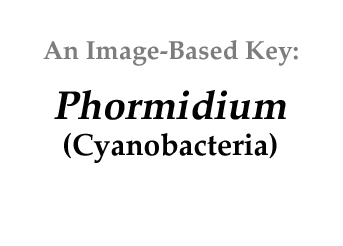|
Home / Cyanobacteria / Filaments / Unbranched
/ Untapered
/ No_heterocysts / Visible_sheath / Phormidum |
|
||||
|
|||||
|
|||||
|
|||||
 |
 |
||||
|
|||||
|
|
|
||||
|
|||||
|
Click
on images for larger format |
|
||||
Name derivation: |
|
||||
|
Phorm– (Gr.) φορμός, basket, mat (Oren
2011) - a reference to the mat of
intertwined filaments. |
|
||||
Classification: |
|
||||
Phormidium Kützing ex Gomont 1892; 172 of 652 species descriptions are currently accepted taxonomically (Guiry and Guiry 2013).Order Oscillatoriales; Family Phormidiaceae |
|
||||
Morphology: |
|
||||
|
Trichome lacking heterocysts, not tapered, and having a sheath extending
beyond the end of the trichomes. |
|
||||
|
Inducible
defence against ciliate attacks: |
|
||||
|
Pseudomicrothorax can ingest long trichomes of Oscillatoria. Filaments of Phormidium sp. have an inducible reaction to attacks by
the ciliate. When a Pseudomicrothorax
initiates ingestion from one end of the filament, the trichome
retreats inside its sheath leaving an apparently indigestible end to the
filament. If attacked at a
non-terminal position along the filament, the trichome
fragments and the two shorter trichomes produced move in opposite directions
away from the area (Fialkowska and Pajdak-Stos 1997). Ingestion
velocity of Oscillatoria formosa
trichomes has been measured at >15 μm s-1
(Hausmann 1980). See videos 1 minute
and 10 minute.
|
|
||||
Similar genera: |
|
||||
|
Pseudophormidium is not separated in Phycokey. |
|
||||
Competition with Microcystis: |
|
||||
Under nutrient-limited growth conditions Phormidium outcompetes Microcystis at all N:P supply ratios of 11, 22, 44 and 89 and lower (20 C) temperature, but the reverse happens with at the 11, 22 and 44 supply ratios but higher temperature (25 and 30 C). Yet at the highest supply ratio of 89 and 25 or 30 C, neither clearly outcompeted the other (Fujimoto et al. 1997). |
|
||||
Anti-cancer agents: |
|
||||
Two of several isolated diacylglycerols (DGDGs) inhibited development of epithelial papillomas in mice (Tokuda et al. 1996). |
|
||||
Toxicity: |
|
||||
Anatoxin-a (Sivonen and Jones 1999). |
|
||||
Habitat: |
|
||||
|
Filaments
form mats on various aquatic substrates (mainly freshwater, some in marine
littoral area) and even wet soil. Some
species are extremophiles in hot springs or desert
sands and soils. |
|
||||
|
|||||
References: |
|
||||
|
Guiry, M.D. and G.M. Guiry 2013. AlgaeBase. World-wide electronic
publication, National University of Ireland, Galway. http://www.algaebase.org; searched on 15
May 2013. Fialkowska, E., and A. Pajdak-Stos 1997. Inducible defence
against a ciliate grazer, Pseudomicrothorax dubius, in two strains of Phormidium
(cyanobacteria). Proceedings of the
Royal Society of London B 264:937 – 941. Fujimoto, N., R. Sudo, N. Sugiura and Y. Inamori. Nutrient-limited growth of Microcystis
aeruginosa and Phormidium tenue
and competition under various N:P supply ratios and
temperatures. Limnology and
Oceanography 42(2):250-256. Gomont,
M. 1892 '1893'. Monographie
des Oscillariées (Nostocacées
homocystées).Annales des Sciences Naturelles,
Botanique, Series 7 16: 91-264, Plates 1-7. Hausmann, C. 1980. Nahrungsaufnahme und
Verdauung bei dem Ciliaten Pseudomicrothorax dubius. Online video. Oren, A. 2011.
Naming Cyanophyta/Cyanoacteria
– a bacteriologist’s view. Fottea 11(1):9-16. Sivonen, K., Jones,
G., 1999. Cyanobacterial toxins. In: Chorus, I., Bartram, J. (Eds.), Toxic
Cyanobacteria in Water: a Guide Line to Public Health Significance,
Monitoring and Management. E&FN Spon, UK,
London, pp. 41–111. (online) Tokuda, H., H.
Nishino, H. Shirahashi, N. Murakami, A. Natatsu and J. Sakakibara 1996.
Inhibition of 12-Optetradecanoylphorbol-13 acetate promoted mouse skin
papilloma by digalactosyl
diacylglycerols from the fresh water cyanobacterium
Phormidium tenue. Cancer Letters 104:91-95. |
|
||||



